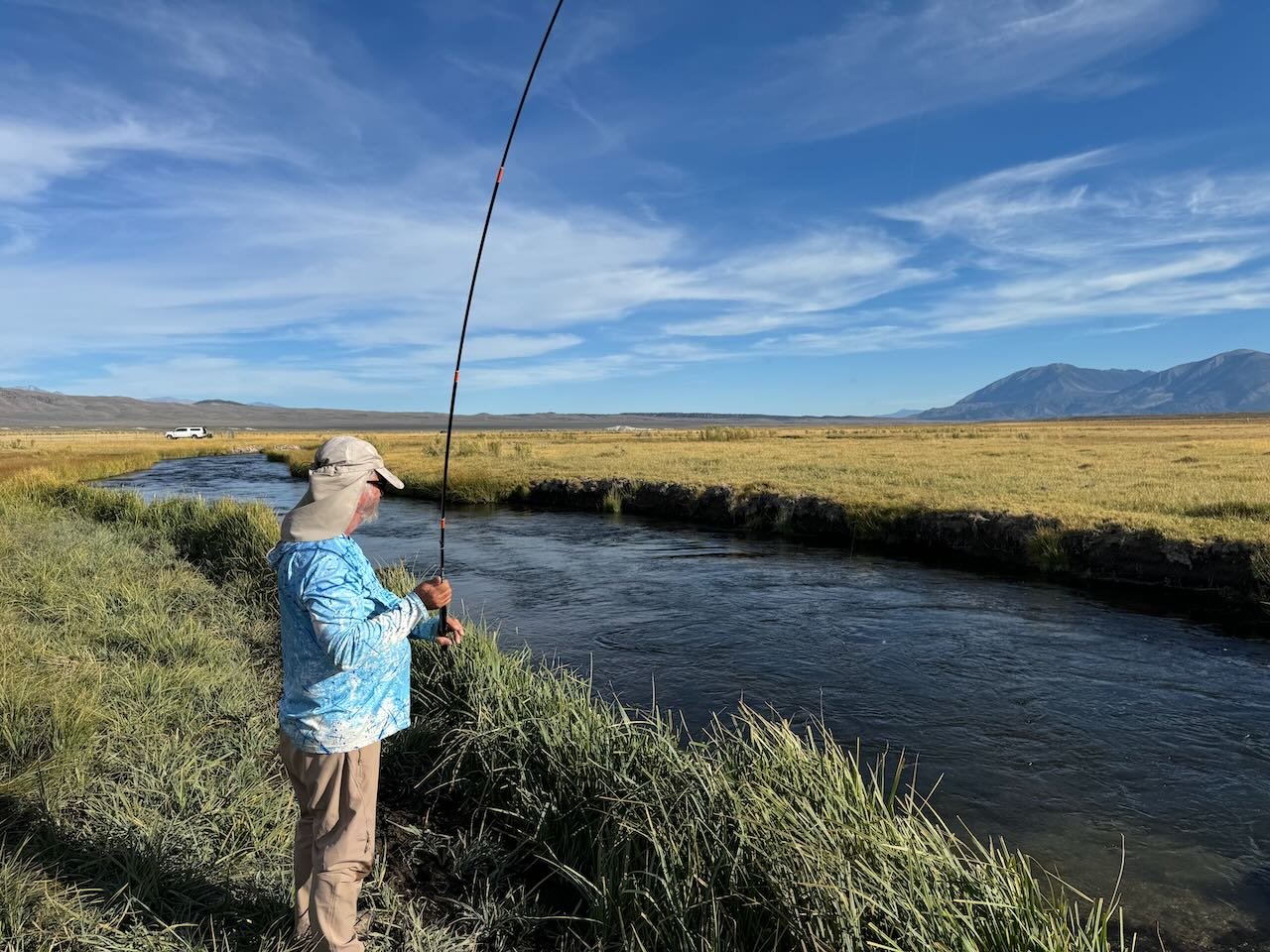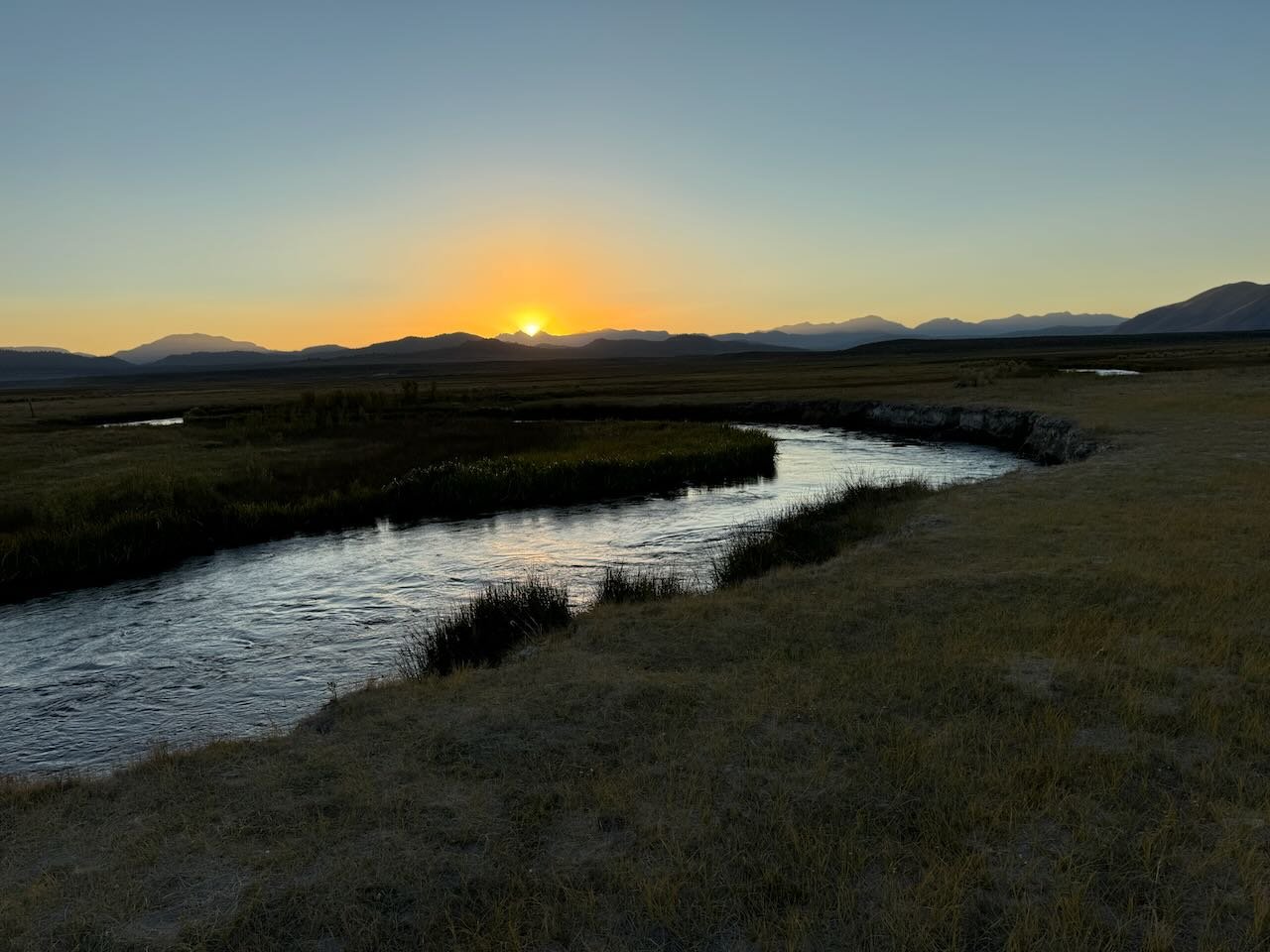Perfect fall weather is why I like the month of Septomber, the 15th of September to the 15th of October. Mornings are cool, mid-day is warm to almost too hot and then it cools off again in the evening. Fall color is in full swing at upper elevation waters. The bright colors of the leaves makes for a beautiful back drop to the fly fishing waters of the Eastern Sierra in fall. Hatches of mayflies, midges and caddis are keeping the trout actively feeding on nymphs and streamers. Now is the perfect time to get in that last fly fishing trip before the snows of winter lock up upper elevation waters. Fall is the perfect time to be throwing meat flies. Those big articulated streamers that offer trophy trout a mouthful of calories.
Being hooked up to a trout on the Tenkara rod is a great way to finish up a day of fall fly fishing.
Hot Creek
Interpretive Site:
Wild brown and rainbow trout are feeding on midges, mayflies and caddis. Mid-morning is offering good opportunities for catching wild brown trout and rainbow trout. The morning trico hatch is a good time to offer the trout a size 22 female dun parachute and then follow it up with a size 22 trico spinner when the spinner fall takes place right after the tricos hatch into the duns. Gray caddis are present in the morning and fishing with a size 20 gray elk hair caddis, gray parachute caddis and gray X-caddis will fool the surface feeding trout. Look for the blue wing olive mayflies to end the morning hatch. Fish a size 20 blue wing olive parachute, sparkle dun and Adams parachutes.
When the word gets out that the hatches are bringing the trout to the surface to feed, fly fishers flock to the creek.
Hot Creek
Canyon Section:
Dry fly fishing or a dry and dropper method is the productive method for fly fishing in the canyon right now. Using a size 16 Adams parachute for the indicator fly allows me to see the fly and still small enough that trout will take it. I’m fishing two different methods behind the Adams parachute. In the first method I’m using a small dry fly behind the big Adams to imitate the hatching insects. I’m fishing a size 20 gray elk hair caddis, size 20 gray parachute caddis, size 20 blue wing olive parachute and a size 20 sparkle dun. The other way I fish I’m using a size 18 olive quilldigon, size 18 bead head flash back pheasant tail nymph, a size 18 bead head flash back gold ribbed hare’s ear and a size 20 tiger midge tied on three feet of 5X fluorocarbon tippet.
Float tubers and boats are working the flats in the north arm of the lake with midge patterns.
Crowley Lake
Mouth of the Owens River:
Midging in 10 to 15 feet of water in the north arm of Crowley Lake has been the productive method of fly fishing the lake. Fly fishing with size 18 albino Barron’s, blood midges, gray midges, zebra midges and tiger midges is producing 14 to 20 inch rainbows, browns and cutthroats. Start off the morning working your midges three to six inches above the mud bottom. As the morning progresses move you midges higher up the water column. I love throwing streamer patterns like wooly buggers, olive matukas and balanced perch this time of year in and around the remaining weed beds. Lake levels are dropping to normal fall levels.
Hatches of midges and caddis activity on the river makes fly fishing the Owens River at sunset a great way to end a day of fly fishing..
Upper Owens River
Above Benton Crossing Bridge:
The fly fishing has turned technical on the upper Owens River above Benton Crossing Bridge. Fly fishers need to be able to present dries and nymphs with a drag free drift and have the fly pattern that is imitating the stage of the insect the trout are feeding on. For the fly fishers nymphing remember that sets are free and set the hook on any movement of the indicator or sighter line. Nymphing with size 18 bead head flash back pheasant tail nymphs, size 18 olive quilldigons and size 16 hot spot pheasant tail nymphs is producing rainbows and browns to 12 inches and the occasional trophy trout to 20 inches. Size 16 Adams parachutes, size 18 blue wing olive parachutes, size 16 elk hair caddis and size 8 olive wooly buggers are producing trout. There is no concentration of trophy brown trout or rainbow trout in the river. Fly fishers nymphing with size 12 stoner nymphs, size 12 green/gold Prince nymphs and size 12 bead head flash back gold ribbed hare’s ears in the deep pools, deep runs and cutbanks will find a few trophy trout willing to take these flies.
Bishop Creek Canal is a great water to learn how to Euro nymph on.
Bishop Creek Canal
Behind Bishop Veterinary Hospital:
I’ve been having mixed results nymphing in the canal depending on water clarity. Off color water has the trout lock jawed. If the water is fairly clear the nymphing with an indicator or a Euro rig has been good. . Size 18 bead head flash back pheasant tail nymphs, size 16 bead head flash back gold ribbed hare’s ears, size 18 olive quilldigons and size 14 hot spot peasant tail nymphs are the nymphs the trout are feeding on.





